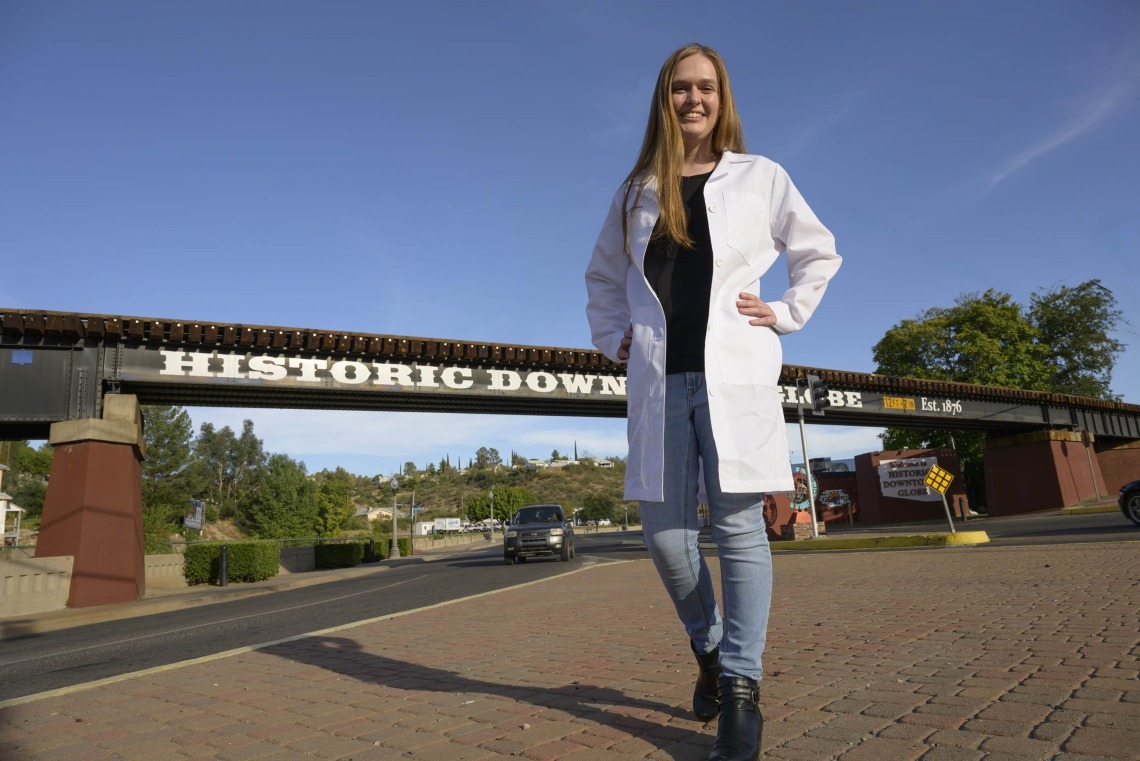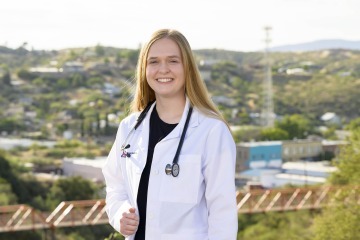Addressing Arizona's rural physician shortage

Emma Rautenberg’s familiarity with rural communities inspired her to pursue a career as a primary care physician to help those in need of greater access to health care.
Emma Rautenberg grew up on two of Arizona’s Native American reservations and would like to return someday to practice as a primary care physician.
Arizona is home to the third-largest population of Native Americans in the United States. According to the Center for Rural Health at the University of Arizona Mel and Enid Zuckerman College of Public Health, the state’s rural population is 15% Native American, and more than half of Arizona’s 15 counties include reservation lands within their borders. These communities, and other rural areas across Arizona’s vast landscape, have faced barriers to health care access for years.
Emma Rautenberg is not Native American, but she knows the health care burdens these communities face as well as anyone. For the first 13 years of her life, she lived in Whiteriver, Arizona, a community on the White Mountain Apache Reservation three hours east of Phoenix. Through her parents’ work in ministry and education, Rautenberg and her three younger siblings grew close with the residents.
“The fact that I’m not Apache did not seem to matter to me or to my Apache ‘grandmas,’ who rocked me in my cradleboard and taught me to make frybread, or to my classmates as we played basketball, joked and rode the Tribal Fair parade floats in camp dresses. We were simply part of a big extended family,” Rautenberg said.

Emma Rautenberg was one of 25 new recipients of the Primary Care Physician Scholarship. She intends to practice in a rural health care setting such as those she grew up in near the White Mountain and San Carlos Apache Reservations after she completes her residency.
At age 13, Rautenberg said goodbye to her Apache friends and neighbors when her parents were asked to further a ministry and school on Grenada, an island in the Caribbean. Three years later, the family moved back to Arizona, where they still reside. Home is now in Peridot, a small community east of Phoenix within the San Carlos Apache Reservation.
“In the communities where I lived, I saw how access to care is one of the biggest challenges to improving rural population health,” Rautenberg said. “I watched people I love and care about struggle to find quality, affordable medical care. I saw close family friends flown to Phoenix because the reservation’s health care facilities did not have adequate room, equipment or specialty personnel who could treat their urgent conditions.”
Rautenberg wants to be part of positive change for these communities. Now a first-year student at the University of Arizona College of Medicine – Tucson, Rautenberg is an awardee of the Primary Care Physician Scholarship Program, which will cover her tuition costs and position her to practice primary care in a rural or urban underserved community in Arizona.
Witnessing the challenges

The Rautenbergs moved from Arizona to Grenada when Emma (far left) was 13. She is the oldest of four siblings, including (from left) sister Allyana and brothers Josiah and Samuel.
Well before the COVID-19 global pandemic, Arizona was facing a shortage of nearly 600 physicians. As COVID-19 spread around the world, rural communities were hit the hardest, according to data from the CDC Provisional Mortality Statistics. Apache County had the highest excess death rate of any large county nationwide in both 2020 and 2021, while neighboring Navajo County, where Rautenberg grew up, had the fourth-highest rate in 2020 and second-highest in 2021.
Post-pandemic, Arizona continues to face a significant shortage of physicians. The Center for Rural Health’s 2023 physician workforce report noted that Arizona has primary care physician shortages in all counties and is worse in rural areas. The report is based on data used by the Health Resources and Services Administration to identify Health Professional Shortage Areas, or HPSAs. The White Mountain and San Carlos Apache Reservations each have an HPSA score of 21, the highest among Arizona's tribal nations.
Rautenberg believes the shortage of physicians combined with other barriers such as medical costs and simple distance to and from providers lead many rural residents to forgo their primary care.
“For most of my life, health care was not readily available. My parents became really good, like a lot of rural residents must do, at identifying a medical condition and determining if it might require a doctor or specialist. Whenever we did have a health concern, we had to travel 30 minutes to several hours, which often made scheduling, testing and prescription pick-ups difficult, not just for my family but anyone in our community.”
Becoming part of the solution
When Rautenberg returned from Grenada, she lived with a host family during the week to attend high school in Phoenix. The obstacles of living in a rural community remained close, though, as her brother Josiah dealt with a puzzling health condition at home in Peridot.
After returning from the Caribbean, Josiah fell ill with vomiting, loss of appetite and allergy-like symptoms. As the family scrambled to find care, they started with a primary care facility in Globe, Arizona, about 20 miles away. Josiah was referred to an allergy specialist in Phoenix, which necessitated a four-hour round-trip journey for each appointment. Eventually, it was discovered the illness was caused by a parasite that had damaged his intestinal lining.
Fortunately, dietary changes helped Rautenberg’s brother recover. It was not a life-threatening situation for him, but Rautenberg knows it can be for many people in rural areas. She has seen the desperation on the faces of people with nowhere to go for treatment. It is those people she wants to help the most.

Emma’s father, Daniel Rautenberg (middle), is surrounded by his four children on a hilltop overlooking Globe, Arizona, the rural town about 20 minutes from their home in Peridot.
“These are the communities I’ve grown up in and I know that these are the people I want to work with as a physician,” Rautenberg said. “The challenges in rural communities are not insurmountable.”
At the top of Rautenberg’s priority list for improving rural health care is increasing access to telehealth consultations for continuing care. She believes if people don’t have to drive long distances for doctor visits, they would be more likely to stay up to date on health care.
“The challenges in rural communities are not insurmountable.”
—Emma Rautenberg
“Many rural patients are unable or unwilling to take the time or have the resources to visit their doctor on a regular basis. They may also be unable to travel to obtain prescriptions or receive therapy,” Rautenberg said. “This can lead to the development of much more serious health outcomes that could likely be avoided.”
She believes primary care physicians in rural areas are better qualified to determine the feasibility of treatment plans based on their local knowledge and familiarity with the community. Further, she thinks local primary care physicians can work with local public health organizations and schools to promote healthy lifestyles.
Rautenberg is uniquely qualified to know that these changes could make a positive impact. Research has shown that medical students who grew up in a rural area are up to four times more likely to practice in a rural setting. The White Mountain and San Carlos Apache Reservations top her list of preferred places to practice after she completes residency and fulfills her commitment to serve as a primary care physician in Arizona.

